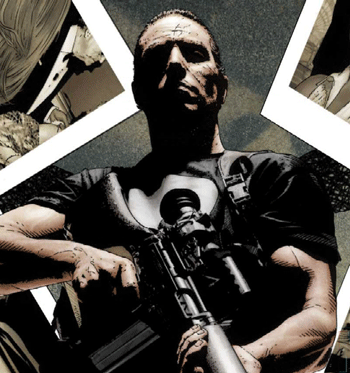 Sir Isaac Newton’s third law of motion (published in Philosophiae Naturalis Principia Mathematica in 1687) is, “To every action there is an equal and opposite reaction.” While this is specifically a law of physics, the broader issues of causality and the relationships between opposing forces have been fertile ground for philosophical discussion for hundreds of years.
Sir Isaac Newton’s third law of motion (published in Philosophiae Naturalis Principia Mathematica in 1687) is, “To every action there is an equal and opposite reaction.” While this is specifically a law of physics, the broader issues of causality and the relationships between opposing forces have been fertile ground for philosophical discussion for hundreds of years.
Even comic book lore has dabbled in such questions. Many readers have heard arguments stating that without evil, there would be no context by which to identify goodness. In a manner of speaking, goodness cannot exist without evil. This idea has been explored in many comics, including the heavily psychological mythos of Batman. Various writers have played with the idea that Gotham’s many costumed criminal lunatics may have come about as a direct consequence of Bruce Wayne’s own decision to play dress-up. The notion of “escalation” has also been probed—that the existence of costumed heroes naturally results in the rise of costumed villains, and that for every heroic feat performed there is an increasingly violent act of depravity perpetrated.
Perhaps one of the clearest, simplest examples of causality in comic books is the story of the Punisher. Whether you see the Punisher as a hero, an anti-hero, a threat to society, or just a flat-out crazed serial killer, one thing is very clear: why he does what he does.
Before becoming the Punisher in 1976, Frank Castle was enjoying a picnic in New York’s Central Park with his wife, Maria, and their children, Lisa and Frank Jr. This picture perfect family moment turned into a nightmare when the Castles witnessed a gangland execution. The perpetrators then turned their guns on the family in an attempt to eliminate witnesses. Frank survived, but his wife and children did not. He identified all of the shooters, but justice was denied as the criminals’ Mafia ties protected them from the law.*
A decorated soldier, Frank vowed to use his extraordinary skills and combat experience to punish his family’s killers and anyone else who would endanger innocents through criminal enterprise. Seeking the utter physical destruction of all criminals, Frank adopted the identity of the Punisher and committed himself wholly to performing the roles of Judge, Jury, and Executioner while conducting a one-man war on crime. As such, the Punisher views killing, kidnapping, coercion, and torture as acceptable crime-fighting tactics.** Not unlike Gotham’s Dark Knight, Frank painted an ominous symbol on his Kevlar Body Armor to strike fear into the hearts of those he hunted, and perhaps more importantly, to draw gunfire to his protected chest (and away from his unshielded head).
Cause: the cold-blooded murder of the Castle family. Effect: the destruction of well over two thousand criminals over the following thirty years.
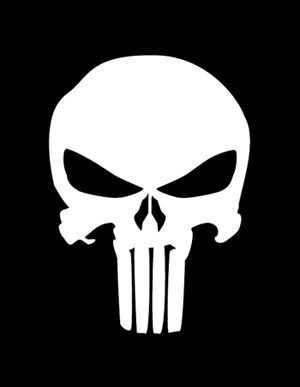
Unlike almost every other comic book character, the Punisher has not been granted immunity from the ravages of time. Whereas Superman is only a few years older than he was when he first appeared seventy-five years ago, Frank Castle’s personal history is closely linked to real-life historical events, including most significantly the Vietnam War. Paradoxically, the Punisher has aged normally while the rest of the Marvel universe is locked in traditional “comic book time.” Promotional art for the cover of issue #44 of the current MAX ongoing series was set to reveal Frank’s birth date as February 16, 1950—making him fifty-seven years old—but was removed before publication.** This makes him one very tough old man, but also creates some continuity headaches given his interactions with other Marvel universe characters. It is difficult to say if the MAX series approach (and specifically that of writer Garth Ennis) to the Punisher’s personal continuity will continue, but it would be fair to expect that if Punisher comics continue to be published with Frank Castle as the central character, then at some point in the not too distant future, he will get some kind of traditional comic book tweak. This could come in the form of some kind of “de-ageing” (similar to Nick Fury), or an updating of Frank’s continuity that removes his Vietnam history, perhaps in favor of a more recent war or conflict. Whatever happens to the Punisher’s continuity in the future, I have to admit that I really enjoy Ennis’s unique take on Frank, as it gives an extraordinary amount of depth and texture to the character.
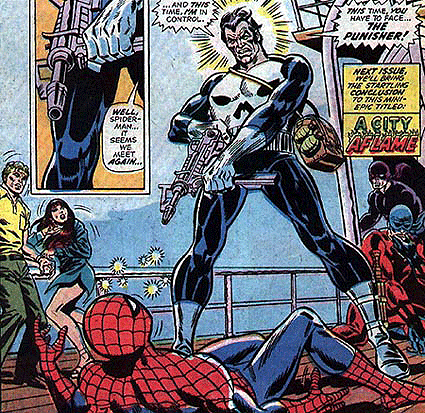
The Punisher was created by writer Gerry Conway and artists John Romita Sr. and Ross Andru, and he first appeared in Amazing Spider-Man Vol. 1 #129 in February 1974 (some keen observers might have noticed that this date predates the date now established as the time of Frank’s family’s murder as mentioned above—no character is safe from comic book continuity shenanigans). The Punisher was initially an antagonist for Spider-Man, having been tricked by the villainous Jackal into attacking the hero. The character was an instant hit and made guest appearances in Spider-Man titles and other popular series throughout the 1970s.
In the early 1980s, artist Mike Zeck and writer Steven Grant pitched a Punisher series to Marvel, but the company was reportedly uncomfortable with the idea of a protagonist who killed in cold blood. In 1986, though, it was decided to test the market with a Punisher miniseries. After the first issue immediately sold out despite very little promotion, this limited series was extended from four issues to five.** An ongoing series was launched the following year and ran for 104 issues until July 1995. Two spin-off titles, The Punisher War Journal and The Punisher War Zone, commenced in 1988 and 1992 respectively and were both wrapped up at the same time as the original series.
In the end, many people believe that the Punisher fell victim to over-exposure, having featured in three solo series as well as numerous one-shots, limited series, and guest appearances in other titles. It seemed that the light that burned the brightest only burned half as long. All of the Punisher books were cancelled in 1995 due to poor sales.
Marvel re-launched the book almost immediately, but it only lasted eighteen issues and ended with Frank Castle catching a bad case of death. A four-issue miniseries called The Punisher: Purgatory was published in 1998 and resurrected our favorite homicidal vigilante as an agent of Heaven. But Frank brandishing blessed guns and punishing dirty demons stuck in the craw of some fans. The miniseries was a commercial success, but not so much a critical one. It was followed by another four-issue miniseries shared with fan-favorite mutant Wolverine and drawn by popular artist Pat Lee.
The true revival of the character arguably didn’t come until the aforementioned Garth Ennis showed Marvel and the world that he understood what made the Punisher tick. Ennis gave the first indication of his special knowledge of Frank Castle in the 1995 What If . . . one-shot, The Punisher Kills the Marvel Universe. In it, Frank’s family is killed in the crossfire of a battle between the X-Men, the Avengers, and the Brood. Blaming super heroes in general, Castle systematically kills every hero and villain in the Marvel universe, allowing himself to be manipulated by some very unsavory characters in the process.
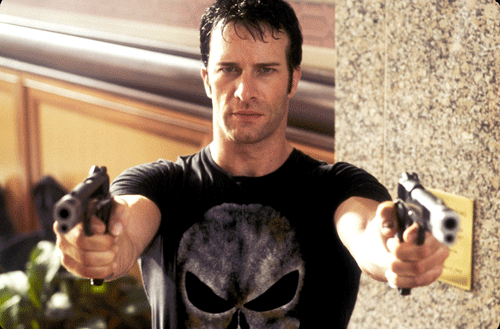
Ennis backed up this brilliant, alternate tale of the Punisher with a twelve-issue miniseries published under the Marvel Knights imprint in 2000. Informally titled Welcome Back, Frank, this run was characterized by a back-to-basics approach and elements of pitch-black comedy. Fans of the 2004 film adaptation starring Thomas Jane (not to be confused with the Dolf Lundgren film from 1989) would recognize many elements that were directly inspired by this story arc, including Frank’s neighbors and the killer for hire known as The Russian.
This miniseries was followed by a similarly popular ongoing Marvel Knights series that lasted thirty-seven issues from 2001 to 2004, before morphing into one of the marquee titles in Marvel’s new, mature-reader oriented MAX line. Introduced by the 2004 four-part miniseries Punisher: Born, which explored Frank’s history in the Vietnam War and outlined the true genesis of his transformation into the Punisher (occurring long before the murder of his family), The Punisher: MAX is currently one of my favorite ongoing titles. The MAX series is violent, seedy, and definitely isn’t for young readers or the faint of heart, but if you like your stories to have a jagged edge and contemporary relevance (tackling issues ranging from the war on terror to corporate fraud), then you should not hesitate to seek out Born and the subsequent series. They come with the added benefit of being very self-contained and easy to enjoy purely on their own merits. Familiarity with Marvel universe continuity and even the Punisher’s individual history is simply not required.
In terms of personal history, the Punisher was born in Queens, New York, to parents of Sicilian ancestry. Born Francis Castiglione, Frank originally studied to become a Roman Catholic priest, but opted for a career change because he was incapable of forgiving those who did evil.* He soon after enlisted in the United States Marine Corps, graduating from basic training and going on to the School of Infantry. Following his training, Frank served in Vietnam as part of a Special Forces unit, in which he was a point man. He fought in numerous engagements and was the sole survivor of a Viet Cong assault on Valley Forge Firebase in 1971 (as depicted in Born). Castle served a total of four years in Vietnam and later ran special “black ops” training missions for Marine recon commandos up until the deaths of his wife and children.
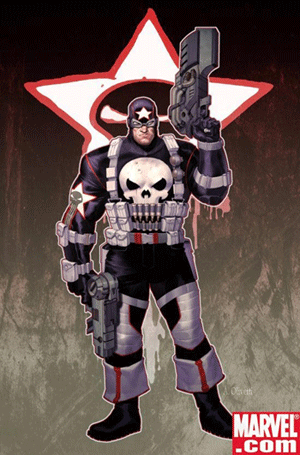
Recently, the Punisher has had greater interaction in the broader Marvel universe, including an involvement in the Civil War event. Frank donned a new Punisher costume in The Punisher War Journal Vol. 2 (with art by well-known Vs. System artist Ariel Olivetti). This new look is inspired by Captain America, who was recently assassinated, and marks a new and completely unique period in the Punisher’s ongoing adventures.
So, how have the good folks at UDE translated the flavor of Frank Castle into our favorite game? There are currently five versions of the Punisher in Vs. System.
Punisher, Judge is a 1-drop Marvel Knights character from the expansion of the same name. This card features artwork by regular Punisher cover artist Tim Bradstreet. It is very close to my favorite Vs. System card image, depicting Frank in an aptly menacing pose and reinforcing that he shows criminals absolutely no mercy. The most obvious theme anyone would ascribe to the Punisher is KO’ing, and this card doesn’t disappoint.
Punisher, Frank Castle is a 3-drop Spider-Friends character from Marvel Team-Up. His affiliation is highly appropriate, as Frank teamed up regularly with Spidey during his early appearances. The version, affiliation, and art suggest that this card represents the Punisher soon after his first comic book appearance in 1974. Frank’s ATK payment power represents his ability to whittle away at an opponent from a long range, as he can reduce a character’s DEF without engaging them in actual combat. This allows a teammate to make easy work of the enemy. I think it also demonstrates Frank’s calculating nature and tactical prowess.
Punisher, Vigilante is a 4-drop from the Web of Spider-Man expansion. This was the first-ever Vs. System incarnation of the character. Once again, we see a highly appropriate KO power, which allows Frank to finish off any stunned character he chooses.
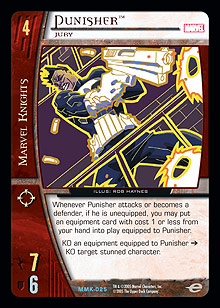
Punisher, Jury is a 4-drop Marvel Knights character. In addition to being the central character in the Judge, Jury, and Executioner series of characters, this was also one part of the historic first set of “stacker” Vs. System cards, along with Daredevil, Matt Murdock. In terms of flavor, if KO’ing is the most obvious and natural theme for the Punisher, then equipment is not too far behind. Given Frank’s mastery of weapons (see Punisher’s Armory), it’s quite appropriate that he be able to utilize equipment in a unique and highly effective way. His triggered effect makes him the quickest draw in the game and allows him to get the drop on opposing players with whatever piece of equipment you have in hand. Another thing that makes this one of the most flavorful versions of the character is that he also has a synergistic KO’ing power that represents Frank’s use of firearms to finish off his opponents.
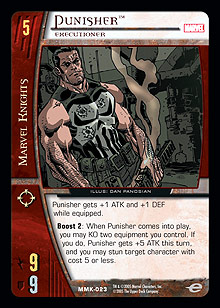
Punisher, Executioner is a 5-drop Marvel Knights character. Similarly themed around equipment, this version of the Punisher can be absolutely huge, depending on what ordinance he’s packing. Alternatively, he can offer great utility if he has access to something like his trademark War Wagon. Executioner’s boost power allows him to take out an opposing character outside of combat if you have the equipment to KO, which I believe nicely represents his sniper skills.
The Punisher has not made a big splash in Vs. System play to date (despite Punisher, Jury threatening to do so as part of the Black Panther, King of Wakanda Fate Artifact deck that prompted last year’s unique equipment rule change), but I look forward to the day when the above cards come together in a new, effective, and synergistic way. Otherwise, there may yet be powerful new versions of Frank created for our amusement. Fingers crossed.
In conclusion, please find below a short recommended reading list regarding the Punisher:
- Essential Punisher Vol. 1 – Normally, I’d recommend the single issues and then note that they were republished (this time in black and white) in a collected edition, but the Punisher’s early appearances were mostly guest appearances and were spread over many different titles. This collection also contains the first The Punisher mini-series from 1986.
- Daredevil Vol. 1 #182–184 (1982) – Frank Miller, writer. (Republished in Daredevil/Punisher: Child’s Play TPB, but you’ll get greater enjoyment from reading the same story in the broader context of Daredevil stories republished in Daredevil Visionaries – Frank Miller Vol. 2 and Vol. 3)
- Punisher: Born #1–4 (2003) – Republished in Punisher: Born TPB.
- What If: The Punisher Kills the Marvel Universe (1995) – Republished in The Punisher Vol. 1: Welcome Back, Frank TPB.
- The Punisher: Welcome Back, Frank Maxi-Series #1–12 (2000) – “Welcome Back, Frank” (republished in The Punisher Vol. 1: Welcome Back, Frank TPB).
- The Punisher – MAX #1–6 (2004) – Republished in Punisher MAX Vol. 1: In The Beginning TPB.
- The Punisher – MAX #13–18 (2005) – Republished in Punisher MAX Vol. 3: Mother Russia TPB.
- The Punisher – MAX #19–24 (2005) – Republished in Punisher MAX Vol. 4: Up is Down and Black is White TPB.
See you in the funny pages,
Michael Pittman
ikeebear@hotmail.com
* www.marvel.com
** Wikipedia.com